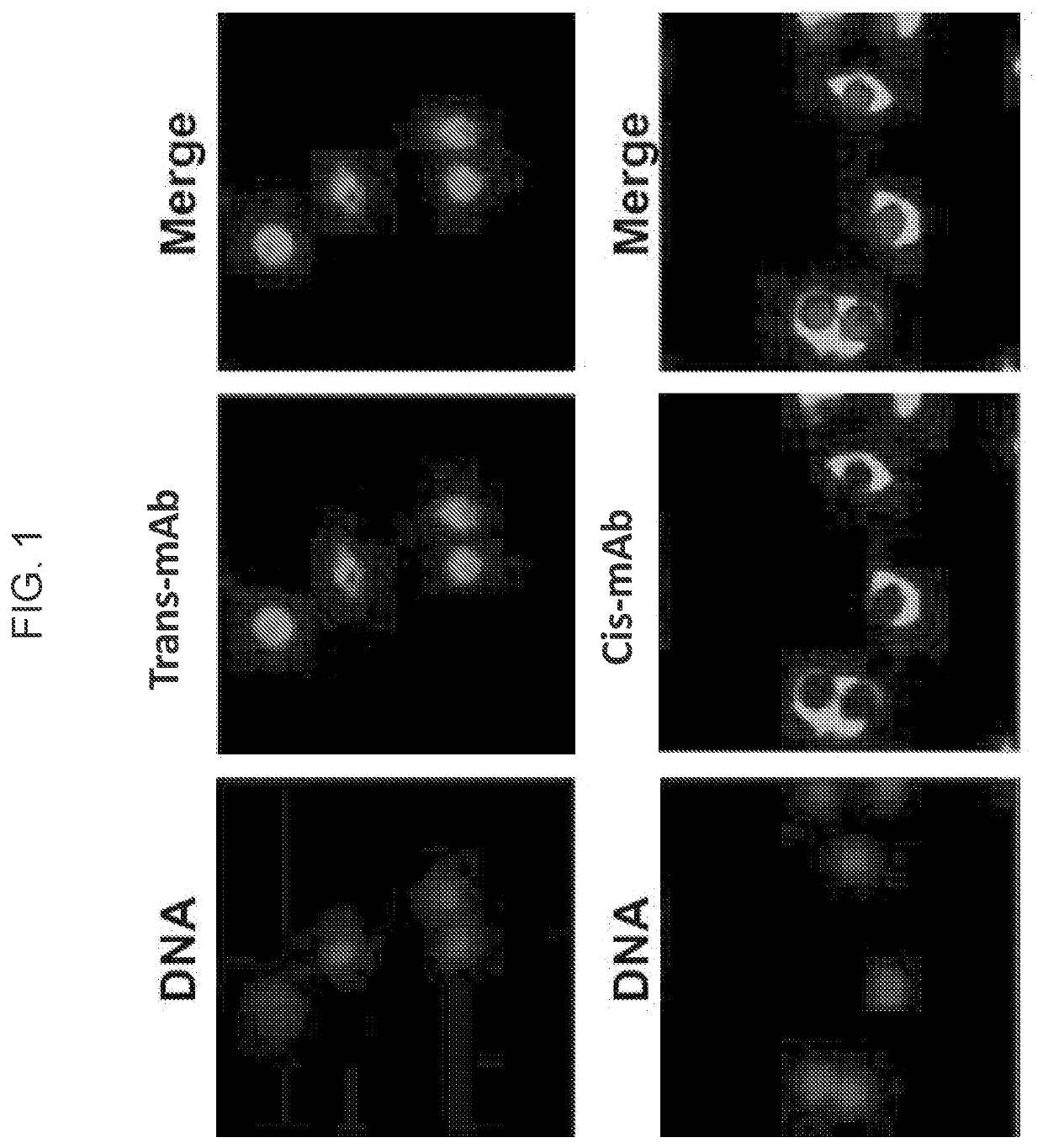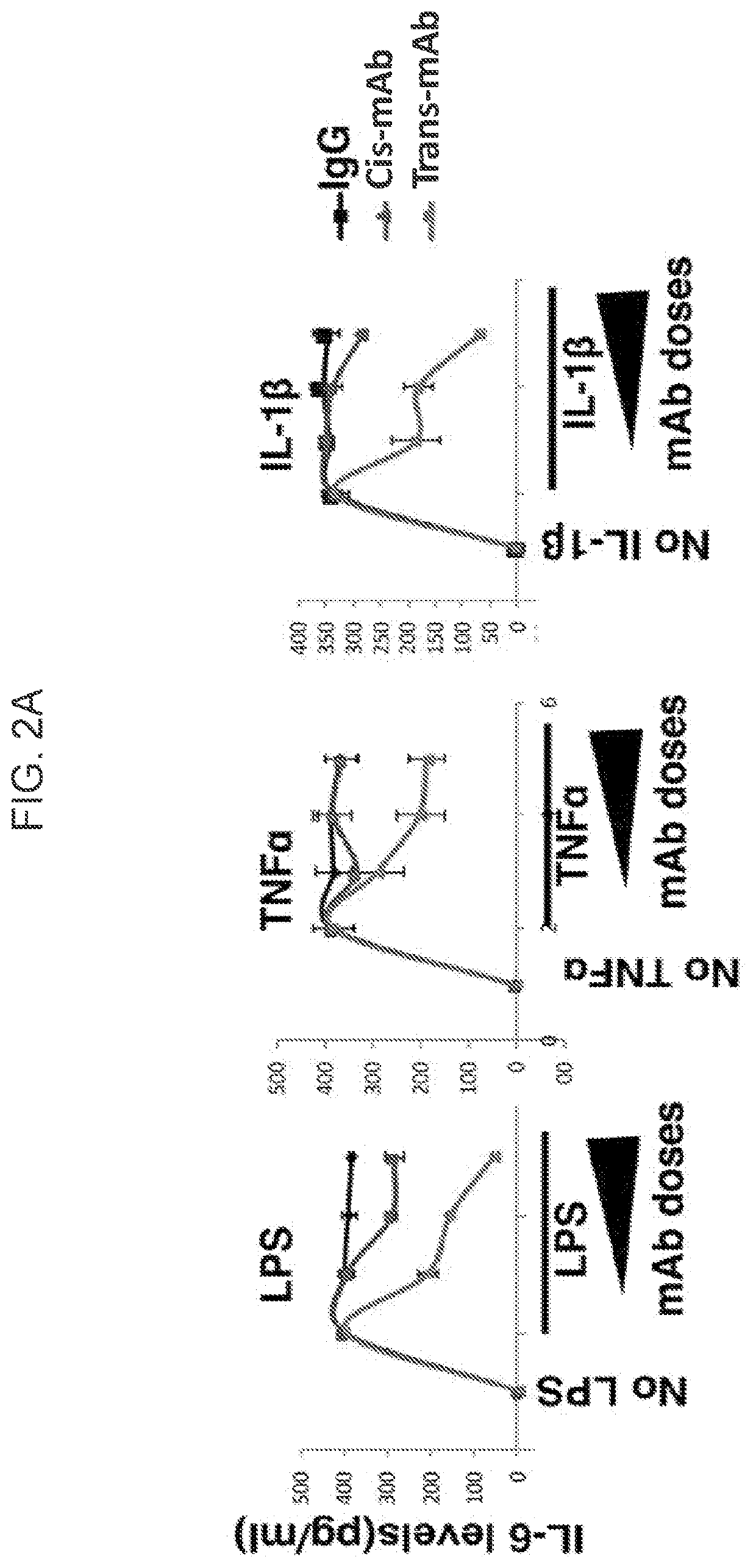Conformation-specific antibodies that bind nuclear factor kappa-light-chain-enhancer of activated b cells
a technology of b cell activation and formation-specific antibodies, which is applied in the field of formation-specific antibodies, can solve the problems of rapid and uncontrolled extreme activation of the innate immune system, damage to and failure of many organs and organ systems
- Summary
- Abstract
- Description
- Claims
- Application Information
AI Technical Summary
Benefits of technology
Problems solved by technology
Method used
Image
Examples
example 1
n and Sequencing of Antibodies Selective for Cis and Trans pThr254-Pro Motif of the p65 Subunit of NF-κB
[0421]We developed novel antibodies selective against the cytoplasmic (cis) or nuclear (trans) form of NF-κB by raising mouse monoclonal antibodies against the p65 subunit of NF-κB that is phosphorylated specifically on the Thr254 residue. Trans-mAbs 1 through 10 were generated by immunizing mice with a pThr254-Pro p65 peptide, followed by generating antibody-producing hybridoma clones using the mouse spleen. A corresponding cis-specific antibody was also generated. The DNA sequences of the light chains (FIG. 8) and heavy chains (FIG. 9) of the trans-mAbs against of the p65 subunit of NF-κB were determined using 5′ RACE RT-PCR techniques. The predicted protein sequences are highly conserved in framework regions, with well-defined complementarity determining regions (CDRs). Some parts of the predicted protein sequences of the light and heavy chains of trans mAbs were also confirmed...
example 2
nt of Monoclonal Antibodies Selectively Against the Nuclear Active Form (Trans-mAb) or the Cytoplasmic Inactive Form (Cis-mAb) of NF-κB
[0423]Immune cells, such as macrophages, dendritic cells, or monocytes, were stimulated with Toll-like receptor ligands such as LPS. NF-κB was induced and localized to two different subcellular locations, as detected by our two different antibodies; one was localized in the cytoplasm and the other was localized in the nucleus (FIG. 1). The monoclonal antibody recognizing the nuclear form is an antibody that specifically recognizes the trans conformation of pThr254-Pro of p65 of NF-κB, while the monoclonal antibody recognizing the cytoplasmic form is an antibody that specifically recognizes the cis conformation of pThr254-Pro of p65 of NF-κB.
example 3
pecific Anti-Nuclear NF-κB Antibody Reduces Cytokine Release in Cell Cultures and Fully Prevents Mortality of LPS-Induced Septic Shock in Animal Models
[0424]To examine the function of the cytoplasm and nuclear forms of NF-κB, we stimulated bone marrow-derived dendritic cells with LPS, TNFα, or IL-1β, followed by treatments with a trans-mAb, a cis-mAb or control IgG. Although there was little effect for the cis-mAb, the trans-mAb dose-dependently inhibited the ability of LPS, TNFα or IL-1β to induce production of cytokines such as IL-6 from dendritic cells (FIG. 2A). These results imply that the trans-mAb against the nuclear form of NF-κB might effectively prevent toxin-induced septic shock death in animal models. To investigate this possibility, we injected mice with a lethal dose of LPS and then injected the mice twice with the trans-mAb or isotype IgG controls at 0 and 4 hours after LPS injection. In the IgG-treated group, LPS robustly induced proinflammatory cytokines such as IL-...
PUM
| Property | Measurement | Unit |
|---|---|---|
| body temperature | aaaaa | aaaaa |
| pressure | aaaaa | aaaaa |
| concentrations | aaaaa | aaaaa |
Abstract
Description
Claims
Application Information
 Login to View More
Login to View More - R&D
- Intellectual Property
- Life Sciences
- Materials
- Tech Scout
- Unparalleled Data Quality
- Higher Quality Content
- 60% Fewer Hallucinations
Browse by: Latest US Patents, China's latest patents, Technical Efficacy Thesaurus, Application Domain, Technology Topic, Popular Technical Reports.
© 2025 PatSnap. All rights reserved.Legal|Privacy policy|Modern Slavery Act Transparency Statement|Sitemap|About US| Contact US: help@patsnap.com



